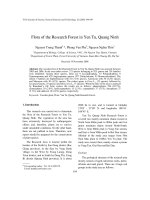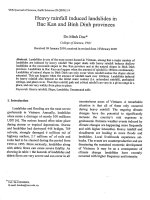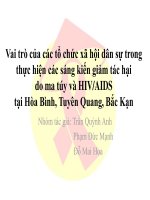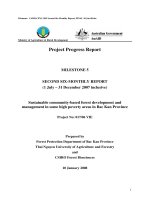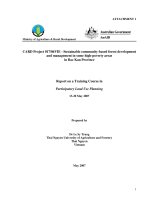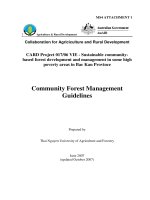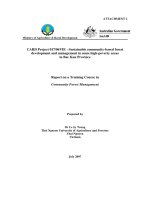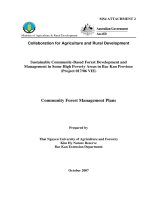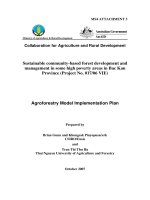Illegal Turtle Trade in Bac Kan, Quang Ninh, Tuyen Quang Provinces and Online Illegal Turtle Trade
Bạn đang xem bản rút gọn của tài liệu. Xem và tải ngay bản đầy đủ của tài liệu tại đây (680 KB, 9 trang )
VNU Journal of Science: Earth and Environmental Sciences, Vol. 32, No. 1S (2016) 245-253
Illegal Turtle Trade in Bac Kan, Quang Ninh,
Tuyen Quang Provinces and Online Illegal Turtle Trade
Tran Thi Khanh Linh1, Pham Van Thong2,*, Le Duc Minh1, Timothy McCormack2
Hoang Van Ha2, Nguyen Tai Thang2, Ngo Thi Hanh1
1
Faculty of Environmental Sciences, VNU University of Science, 334 Nguyen Trai, Hanoi, Vietnam
2
Asian Turtle Program of Indo-Myanmar Conservation
Received 08 July 2016
Revised 19 August 2016; Accepted 01 September 2016
Abstract: Turtle trade is a long-term conservation problem, which drives many turtle populations
in Vietnam to the brink of extinction. In this study, we conducted interview surveys in three
northern provinces in Vietnam, including Bac Kan, Quang Ninh, and Tuyen Quang between 2013
and 2015 to investigate the scale and trend of turtle trade in Vietnam. The results of the study show
that the prices of most species increased alarmingly during the study period, probably due to the
rarity of the species and the higher demand from China. More importantly, our surveys of online
trading activities through social networks suggest that the new method of turtle trade dramatically
rises in recently years, and overtakes the traditional networks as the most common way of trading.
Based on the trend and scale of the trade, we recommend several conservation measures to mitigate
turtle trade, especially formulating new regulations to stop online trading activities.
Keywords: Turtle trade, Bac Kan, Quang Ninh, Tuyen Quang, online trade.
1. Introduction∗
example, the illegal trade in wildlife has
continued unabated since Vietnam opened its
market to China in the early 1990s [3]. In this
context, turtle is not an exception. Freshwater
turtles and tortoises, in some cases serving as
keystone species or an important link in the
food web, play a crucial role in ecosystems.
However, turtle populations around the world
have declined drastically over the past 30 years
[4]. The international trade in turtles is the
biggest threat to their conservation, with turtles
being harvested for food, use in traditional
Chinese medicine and sale in the pet trade [5].
In Vietnam, wildlife mostly comes from
protected areas in Central Vietnam [1,6,7].
Illegal traders find multiple avenues for
Conservation of endangered fauna and flora
is an important, but complex issue at national
and international levels. Despite concerted
efforts of non-governmental organizations,
government agencies, and other stakeholders,
many species still face the prospect of
extinction due to habitat loss and degradation
and illegal trade of wildlife and their related
products [1]. Illegal wildlife trade is a pervasive
and destructive crime that results in serious
biodiversity loss around the globe [2]. For
_______
∗
Corresponding author. Tel.: 84-912984096
Email:
245
246 T.T.K. Linh et al. / VNU Journal of Science: Earth and Environmental Sciences, Vol. 32, No. 1S (2016) 245-253
trafficking species across the border between
Vietnam and China. Smugglers have also begun
to use private vehicles to transport contraband
in order to avoid confiscation [8].
Although collecting wildlife species is
illegal, Vietnam’s traders exported 35.7 tons of
mostly wild turtles a year during the early
2000s [1]. At the beginning, the quantity of
turtles used locally was insignificant,
accounting for only 10% of the harvest [3,9].
However, domestic consumption has increased
recently, although it is difficult to estimate the
volume of this illegal trade [10].
To better understand the evolution of the
trade through time, it is important to determine
the pattern and scale of the turtle trade in
hotspot areas in Vietnam. To this end, this
study, conducted in three provinces, namely
Bac Kan, Tuyen Quang and Quang Ninh,
assessed the trend of turtle trade over the last 10
years. In addition to undertaking traditional
interview surveys, this study also collected data
from online turtle trading, an increasingly
common method for trading wildlife. The trend
of the trade was clarified when two methods of
trading are compared. The study also illustrated
the scale of the illegal trade in turtles, raised the
concerns in this critical threat, and
simultaneously provided baseline data for
future trade monitoring and enforcement
activities vital to turtle conservation.
2. Methodology
Semi-structured interview survey was
conducted in Yen Son district of Tuyen Quang
Province from 10th May to 15th May 2011, in
seven districts of Na Ri, Ngan Son, Ba Be, Pac
Nam, Bach Thong, Cho Don, Cho Moi in Bac
Kan Province 12th to 23rd August 2013, and in
nine districts of Ba Che, Hoanh Bo, Van Don,
Cam Pha, Ha Long, Tien Yen, Dam Ha, Mong
Cai, Binh Lieu of Quang Ninh Province from
29th Jun to 14th July in 2015 (Fig. 1). Turtle
observed were recorded using the field record
form [11] with carapace length, width and turtle
weight and photos attach, and GPS the location.
Turtles were identified base on the standard
identification book entitled “Field Guide Turtle
Identification of Freshwater Turtle and Tortoise
of Vietnam” [12]. Prices of turtles were also
documented [10]. The surveys focused on
interviewing local hunters, traders, farmers.
Online turtle trade surveys were carried out
for two months from March to May 2015 using
search tools from Google and Facebook with
keywords: “Buôn bán rùa”, “Bán rùa online”,
“Page bán rùa”, “Hội yêu rùa”, “Hội yêu rùa Hà
Nội” and “Chợ rùa market”. The volume of
turtle seizure in online newspapers during three
years (2013-2015) was documented by Google
search tool using keywords: “Buôn bán rùa trái
phép 2013”, “Tịch thu rùa trái phép”, “Tịch thu
động vật hoang dã”. Some websites, such as
kiemlam.org, baomoi.com, baohaiquan.vn, and
cand.com.vn, also provided good sources of
data for study.
3. Results and discussion
3.1. Turtle trade in Bac Kan, Quang Ninh and
Tuyen Quang Provinces
Analyses of data collected from surveyed
markets were performed to determine the trade
composition, turtle diversity, common species,
and the differences in price between 2013 and
2015. Turtle trafficking trend was evaluated
using field records to reveal any potential shifts
in turtle trade. The number of individuals from
each geographic region was also examined,
including 11 species recorded in the trade, in
order to detect any trends or changes in the
composition of native species.
During the surveys in three provinces, 253
respondents were interviewed, 122 field records
for 122 specimens were completed. Interviewed
locations covered important areas in the three
provinces (Fig. 1). Among turtles documented
during the surveys, 92,6 % was living
specimen, the rest was dead. In terms of the
number of turtles present in the trade, the old
T.T.K. Linh et al. / VNU Journal of Science: Earth and Environmental Sciences, Vol. 32, No. 1S (2016) 245-253
world pond turtles of the family Geoemydidae
were dominant with 72,95% frequency
including seven species among 17 species of
the family known to occur in Vietnam such as
the keeled box turtle (Cuora mouhotii) has the
highest number (41 individuals), followed by
22 individuals of four-eye turtle (Sacalia
quadriocellata). Especially, one individual of
the Snail-eating Turtle (Malayemys subtrijuga)
observed in Quang Ninh Province has an origin
from Mekong Delta, southern Vietnam. Eleven
Black-breasted Leaf Turtle (Geoemyda
spengleri), seven Asian Yellow Pond Turtle
(Mauremys mutica), two Chinese Striped Turtle
(Mauremys sinensis), five Indochinese Box
Turtle (Cuora galbinifrons). The next most
common family is Platysternidae (19,67%), a
monotypic family containing only one species,
the
Big-headed
Turtle
(Platysternon
megacephalum). Following is the family
Trionychidae with the Wattle-neck Softshell
Turtle (Palea steindachneri) and the Chinese
Soft-shell
Turtle
(Pelodiscus
sinensis)
accounting for 5,73% frequency. The least
common is the family Testudinidae (1,67%)
with the appearance of only one species, the
Elongated Tortoise (Indotestudo elongata)
(Fig. 2).
Quang Ninh Province
Tuyen Quang Province
247
Bac Kan Province
Figure 1. Interview locations in three provinces.
248 T.T.K. Linh et al. / VNU Journal of Science: Earth and Environmental Sciences, Vol. 32, No. 1S (2016) 245-253
Figure 2. Number of turtles present in the trade in the three provinces as categorized by family.
The Keeled Box Turtle (Cuora mouhotii)
appeared most frequently in Tuyen Quang,
accounting for 61,53%. Because Tuyen
Quang’s topography is quite complex,
characterized by high mountains and rivers,
which could be an ideal habitat for this species
[13]. However, Tuyen Quang province had
fewer observed specimen than other provinces.
This might be because turtles had been
overexploited in the province. Several factors
could be attributable to this trend. The province
is bordering with China, and therefore the turtle
fauna has been under a high collecting pressure.
In addition, in the early period of the trade, the
turtle trade route to China went through the
province. On contrary, Bac Kan is not a “border
province”, and the number of recorded turtles in
the province remains the highest [14]. With a
large area of limestone in Ba Be and Na Ri
Districts, Bac Kan is also home to many
species. All the natural conditions constitute
suitable habitat for the Big-headed Turtle
(Platysternon megacephalum). As a result, the
Big-headed
Turtle
(Platysternon
megacephalum) in Bac Kan mad up the highest
ratio, with 37,5%. Meanwhile, in Quang Ninh
Province, the Four-eyed Turtle (Sacalia
quadriocellata) ranks highest in terms of
frequency. This is due to the fact that there are
many rivers such as Ha Coi, Dam Ha, Troi,
Mip, Uong, Cam and Dam [15]. These rivers
are small, short and steep slopes with many
rock, containing suitable habitats for the Foureyed Turtle.
According to interviews, most observed
turtles were ready to be traded or kept as pet
until they reach reasonable price. The number
of recorded specimen clearly illustrate the turtle
trafficking status in the region. There were 26
and 32 specimens observed in Tuyen Quang
and Quang Ninh, respectively, whilst, Bac Kan
had 64 observed samples, which are twice as
many compared to the other two provinces.
These data show that geographical location is
not crucial factor in determining trade activities
because only Tuyen Quang and Quang Ninh are
provinces bordering with China.
Figure 3. Turtle trade route observed in three provinces.
T.T.K. Linh et al. / VNU Journal of Science: Earth and Environmental Sciences, Vol. 32, No. 1S (2016) 245-253
Furthermore, the Snail-eating Turtle
(Malayemys subtrijuga), which originates from
Mekong Delta, southern Vietnam is observed in
Quang Ninh Province. This shows that some
species are transported from other locations to
these regions, or in other words turtle trade
network is still operating effectively in many
areas throughout Vietnam despite efforts to
control it. During these interviews, it is also
clear that there were two or three small local
merchants specializing in wildlife trade in each
commune. From there, wildlife would be
transported to bigger traders in nearby cities. A
portion of the turtles would be consumed in
restaurants in provincial cities. Some are
shipped to Hanoi for consumption. Most of
collected turtles are trafficked to China through
border areas. In many cases, Chinese traders put
in order for certain species or products with
very high prices to middlemen. Middlemen then
ask hunters to look for them in the forests. The
traders are not only the intermediate link
between hunters and consumers, but also an
important factor in the trade network that
causes a high level of damages to turtle
populations across Vietnam (Figure 3).
3.2. Turtle price change through time
Base on average CPI (Consumer Price
Index) in 2014, an increase of 4.09% compared
to those in 2013 was used [16]. Inflation in the
first 10 months in 2015 rises 2.12% compared
to those in the same period in 2014 [17]. The
average price evaluated in 2015 was calculated
based on the inflation rates in 2014 and 2015
and the average real price in 2013, then
compared with the average price in 2015
surveyed in the fieldtrip (Table 1).
The real price of each species is different
depending on trader decision or geographic
origins. Moreover, the price calculated based on
the above formulas for each species is much
lower than the average price recorded in Quang
Ninh in 2015. It is quite clear that the increase
of price was not affected by inflation.
Specifically, Indochinese Box Turtle (Cuora
249
galbinifrons) has its average price in 2015 of
about 3.8 million VND/kg which was 5 times
higher than the price of about 730,000 VND/kg
in 2013. This problem might result from the
high demand from domestic and international
markets, leading to a steep rise in princes of the
species. In general, due to overexploitation,
turtle population deteriorates rapidly, leading to
the scarcity of turtle. When turtle quantity
decreases, the price certainly soars.
In term of the Four-eyed Turtle (Sacalia
quadriocellata), its average price in 2015
ranges from 3 million to 5 million VND which
are two times than average price in 2013.
According to an interview study undertaken in
Pu Mat National Park in 2002, this species was
valued much lower than other species at only
25,000 dong/kg, as it is known to possess bad
smell [18]. Nowadays, when other species are
becoming rare, people collect all turtle species
including species that was not considered
valuable just few years ago (Table 1).
Additionally, there was a special species,
the Black-breasted Leaf Turtle (Geoemyda
spengleri), traded by individual not by weight
as others. In 2013, the price of this species was
only 50,000 VND per individual. However, the
price in 2015 fetched about 250,000 VND,
which is five times higher. The Black-breasted
Leaf Turtle (Geoemyda spengleri) was
preferably used as a pet or for religious release
in pagoda due to its relatively low price
compared to other species. The Asian Yellow
Pond Turtle (Mauremys mutica) has the highest
average price ranging from 20 million to 30
million VND, meanwhile the Chinese Soft-shell
Turtle (Pelodiscus sinensis) costs around
500,000 VND/kg. Nevertheless, the prices of
the two species remain stable with almost
insignificant change over the last two years
(Table 1). The price of the Chinese Soft-shell
Turtle (Pelodiscus sinensis) seems to be
unchanged or even decreases over two years
because there is a large number of the Chinese
Softshell Turtle (Pelodiscus sinensis) produced
by household farms. The Chinese Softshell
250 T.T.K. Linh et al. / VNU Journal of Science: Earth and Environmental Sciences, Vol. 32, No. 1S (2016) 245-253
Turtle (Pelodiscus sinensis) is a popular dish in
restaurants
with
a
reasonable
price.
Additionally, the Asian Yellow Pond Turtle
(Mauremys mutica) is likely to match a high
price in recently years because this species
could hybridize with Vietnamese Three-striped
Box Turtle (Cuora trifasciata) to produce
crossbred animals, which look similar to Threestriped Box Turtle (Cuora trifasciata), the most
expensive species. However, in Viet Nam,
turtle farms in Bac Ninh and Thanh Hoa
Provinces produce the Asian Yellow Pond Turtle
(Mauremys mutica) in a massive numbers leading
stable price for the species [19].
3.3. Online illegal trade
Nobody can deny that social media has
dominantly influenced our lives in many
different ways today. Social networking sites
like Facebook, Myspace, and Twitter are
transforming the ways we interact, share,
communicate, and even trade. Trading has
become easier and more accessible due to the
new ways of networking. Online wildlife trade
has become very popular because all
transactions take place on social networks, and
information can be shared virtually. Prices were
almost quoted inbox to ensure privacy and
avoid enforcement. As a result, online traders
abused the networks to trade wildlife species
including turtles for medicine, food, and pet.
There were 24 main online traders found during
our survey from March to May 2015. In
addition, Cho Rua market page, Hoi Yeu Rua
Canh, Hoi Yeu Rua Kieng, Hoi Bo Sat Viet
Nam can also be considered reference
information channels. Ho Chi Minh and Hanoi
were likely to be the biggest markets for online
turtle trade with 45.83% and 25% traders
originating from Ho Chi Minh and Hanoi,
respectively. Moreover, traders were distributed
ubiquitously throughout our nation, including
Nghe An, Binh Duong, Da Lat, Da Nang, Dak
Lak, and Dong Nai Provinces. Unknown
provinces accounted for the remaining 25% of the
online trader ratio. This suggests that online
trading activities is widespread across the country,
concentrating in Hanoi and Ho Chi Minh City.
The survey results show that at least 346
turtle individuals belonging to 15 different
species were traded in online trade markets. The
family with the largest number of traded species
was Geoemydidae (57.8%), followed by is
Testudinidae family (41.62%). Cheloniidae just
accounted for a tiny ratio (0.58%). Of the
species found in the markets, 100% are listed in
2013 CITES Appendix [20] and 100% are
threatened according to the IUCN Redlist [21],
i.e., listed as Critically Endangered, Endangered
or Vulnerable), meanwhile 54.45% species are
listed are threatened according to Viet Nam Red
Book (2007) [22].
Table 1. Calculated and real price changes in turtles between 2013-2015
Species
Average price
(VND) in 2013
(/kg)
Calculated price
(VND) in 2014
based on CPI
(/kg)
Calculated price
(VND) in 2015
based on CPI
(/kg)
Average price
(VND) in 2015
(/kg)
Cuora galbinifrons
Geoemyda spengleri
600,000-700,000
50,000
624,540-714,840
52,045
650,083-729,994
53,148
Mauremys mutica
Pelodiscus sinensis
20,000,000
500,000
20,818,000
520,450
21,259,340
531,483
Cuora mouhotii
600,000-700,000
624,540-714,840
650,083-729,994
Sacalia quadriocellata
2,000,000
2,008,180
2,050,753
3,800,000
100,000-250,000
20.000.00030.000.000
500.000
800,0001,200,000
3,000,0005,000,000
T.T.K. Linh et al. / VNU Journal of Science: Earth and Environmental Sciences, Vol. 32, No. 1S (2016) 245-253
According to the results of the
investigation, juveniles were the most widely
traded, accounting for 41.33%, followed by
hatchlings (23.99%), sub-adults and adults were
less preferred by customers with 22.54% and
12.14%, respectively. These sizes had different
level of prices. For example, the Elongated
Tortoise (Indotestudo elongata) was most likely
to be purchased as pet with 41,62% frequency
of total species number. This is probably
because this species is very cute and clean,
especially with the baby size. The price of
hatchling individual (size 7 – 7cm) was 680,000
VND, meanwhile a juvenile individual (size 9 –
9 cm) only cost 580,000 VND. Furthermore,
adult size (size 25 – 25cm), three times bigger
than juvenile, was only priced at 1,350,000
VND/animal. Therefore, prices of the turtle are
not affected by weight; they are influenced by
the size of the animals.
In only 2 months of survey, there are 346
individuals were offered for online sale.
According to the figure, the total number of the
illegal online trade might reach 2076
individuals in one year. It is indeed a very high
number, especially for turtles.
3.3. Violations and confiscations in Viet Nam
from 2013 to 2015
There are 82 cases involving 18 species
seized during three years from 2013 until
September 2015. The total confiscated wildlife
contains 1308 heads and 2418.1 kg. The highest
number of cases happened in the year of 2013
with 38 violations equivalent to 886 heads and
2005.6 kg of 14 species. The number of cases
decreased to 29 with 13 species seized or 252 kg
in 2014. Meanwhile, in the first nine months in
2015, there are only 15 confiscations involving
seven species, 150 heads and no weigh was
recorded.
Coming back with assumption in online
trade part, the number of turtle offer for sale in
1 year is 2076 individuals. It means that in 3
years there are 6228 turtle individuals are
traded online. The calculated turtles trafficked
251
were more than 6228 individuals because we
did not calculate off-line trade. However, this
figure is already three times higher than of the
number of confiscated turtle individuals. The
data demonstrate that the confiscated case is
insignificant compared to illegal online trade
activities happening every day.
4. Conclusion
Turtle illegal trade in wildlife continues to
be an unabated problem and turtle populations
has declined severely. Illegal trade trend in
Quang Ninh, Tuyen Quang and Bac Kan
changes significantly compared to that in the
past. There were 122 specimen belonging 11
species observed. All living species were ready
to be traded, kept as pet or offered for sale
when they get reasonable price. There were
three main routes to trade turtle illegally, but the
most common one was exporting turtles to China.
In term of prices, they increased
dramatically compared to previous years due to
high demand from domestic and foreign
markets. Because of overexploitation, turtle
populations deteriorated rapidly leading to the
scarcity of turtle. When turtle quantity
decreases, the price grows up significantly.
However, the prices of the Asian Yellow Pond
Turtle (Mauremys mutica) and the Chinese
Softshell Turtle (Pelodiscus sinensis) remains
stable over the three-year period because there
are many household farms raising the species in
recent years.
In three years, the total confiscated cases
are 82 with more than 2218 kg of turtles and
1288 individuals traded. Confiscated trend
tends to decrease over three years due to
efficient tactics employed by traders and
inadequate law enforcement. By comparison, it
is clear that the confiscated number is
insignificant compared to the volume regulated
by illegal trade activities observed in this study.
Besides, another trading method preferred
recently is online trade. This study recognized
24 traders trafficking at least 346 turtle
252 T.T.K. Linh et al. / VNU Journal of Science: Earth and Environmental Sciences, Vol. 32, No. 1S (2016) 245-253
individuals belonging to 15 different species in
online trade markets during two months of
survey. This is a new trade method which
appears uncommon few years ago. However,
the volume of turtle illegally traded is estimated
to be 2076 individuals trafficked in one year.
The price is determined by size of individuals,
and fluctuates strongly among traders. Online
trade develops quickly and become a huge
threat to wildlife because of the deficiency of
the current law and regulations in punishing
these cases.
In summary, conventional illegal trade
method and online trade method are shown to
be destructive to turtle populations. However,
online trade is spreading with a breakneck
speed. This is indeed alarming to conservation
organizations, and the government needs more
effective measures to better control the illegal
wildlife trade
5. Recommendations
Some recommendations are suggested to
mitigate the problem. According to interviews,
hunters frequently use dog to collect turtles, so
dogs should not be allowed in forests to hunt
turtles. Education and information campaigns
need to be developed to influence the wildlife
eating and drinking culture, and the newly
emerging
pet
keeping
hobby
young
Vietnamese. In addition, rangers and protected
area staff should be equipped with modern
equipment to make sure their work is effective.
Coordination and collaboration with law
enforcement authorities in China should be
improved to better control the illegal crossborder trade. Finally, new law and regulations
should be formulated to effectively stop illegal
online trading activities.
Acknowledgements
We would like to thank the generous
support from the Critical Ecosystem Partnership
Fund and the Mohamed bin Zayed Species
Conservation Fund.
Reference
[1] Nguyen, S.V. (2003), Wildlife Trading in
Vietnam: Why It Flourishes, Singapore.
[2] Ngoc, A.C. and Wyatt, T. (2013), A green
criminological exploration of illegal wildlife trade in
Vietnam. Asian Journal of Criminology 8: 129-142.
[3] Le, D. and Broad, S. (1995), Investigations into
Tortoise and Freshwater Turtle Trade in Vietnam,
IUCN Species Survival Commission, Gland,
Switzerland.
[4] van Dijk, P.P., Stuart, B.L., and Rhodin, A.G.J.
(2000), Asian Turtle Trade – Proceedings of a
Workshop on Conservation and Trade of
Freshwater Turtles and Tortoises in Asia,
Chelonian Research Foundation, MA.
[5] Amanda, J.S. (2015), Analysis of Wildlife
Market Surveys in Guangzhou, China from
2004-2013, USA.
[6] Compton, J. and Le, Q.H. (1998), Borderline: An
assessment of wildlife trade in Vietnam. WWF
Indochina Program.
[7] Nguyen, H.M. (2002), The illegal animal trade
crossing the border from Vietnam to China: A
review of the present state of this activity and
recommendations on how to stop it. Master Thesis,
International University of Andalusia, Spain.
[8] Li, W. and Wang, H. (1998), Wildlife trade in
Yunnan Province, China, at the border with
Vietnam. TRAFFIC Bulletin 18: 21-30.
[9] Hendrie, D. (2000), Status and conservation of
tortoise’s and freshwater turtles in Vietnam. In
Asian Turtle Trade –Proceedings of a Workshop
on Conservation and Trade of Freshwater Turtles
and Tortoises in Asia (eds P.P. van Dijk,B.L.
Stuart & A.G.J. Rhodin), pp. 63–73. Chelonian
Research Foundation, Lunenburg, USA.
[10] Le, M. (2007), Conservation of turtles in Vietnam: a
survey of Cat Tien National Park. Oryx 41: 544-547.
[11] Asian Turtle Program. (2006), Tortoise and
freshwater turtle field record report. Hanoi.
[12] Hendrie, D. (2011), Field guide identification
field guide turtle identification of freshwater turtle
and tortoise of Vietnam.
[13] Điều kiện tự nhiên tỉnh Tuyên Quang. Retrieve
from
/>hu/cactinhvathanhpho/tinhtuyenquang/thongtintin
hthanh?view=introduction&provinceId=1386
T.T.K. Linh et al. / VNU Journal of Science: Earth and Environmental Sciences, Vol. 32, No. 1S (2016) 245-253
[14] Điều kiện tự nhiên tỉnh Bắc Kạn(b). Retrieve from
/>hu/cactinhvathanhpho/tinhbackan/thongtintinhtha
nh?view=introduction&provinceId=1163
[15] Điều kiện tự nhiên tỉnh Quảng Ninh. Retrieve
from
/>hu/cactinhvathanhpho/tinhquangninh/thongtintinh
thanh?view=introduction&provinceId=1376
[16] CPI 2014 so với 2013 (2014). Retrieved from
/>[17] CPI 10 tháng đầu 2015 với 2014 ,(2015).
Retrieved from
/>
253
[18] Espenshade, W.E. and Le, D.T. (2002), “Pu Mat
Turtle Hunter Interview”, Vietnam. Retrieved
from />pp 16-17.shtml
[19] Trang trại Rùa(2002), Retrieved from
/>CITES (2013). CITES Species.
/>[20] IUCN (2013), IUCN Red List of Threatened
Species www.iucnredlist.org
[21] Ministry of Science and Technology and
Vietnamese Academy of Science and Technolgy.
(2007), Viet Nam Red Book. Natural Science and
Technology Publisher.
Tình trạng buôn bán rùa trái phép tại Bắc Kạn,
Quảng Ninh, Tuyên Quang và buôn bán rùa trái phép
qua mạng Internet
Trần Thị Khánh Linh1, Phạm Văn Thông2, Lê Đức Minh1, Timothy McCormack2,
Hoàng Văn Hà2, Nguyễn Tài Thắng2, Ngô Thị Hạnh1
1
Trường Đại học Khoa học Tự nhiên, ĐHQGHN, 334 Nguyễn Trãi, Hà Nội, Việt Nam
2
Chương trình Bảo tồn Rùa châu Á
Tóm tắt: Buôn bán rùa là một vấn đề phức tạp trong công tác bảo tồn khiến các quần thể rùa của
Việt Nam có nguy cơ tuyệt chủng cao. Trong nghiên cứu này, chúng tôi đã tiến hành điều tra phỏng
vấn ở ba tỉnh miền Bắc Việt Nam, trong đó có Bắc Kạn, Quảng Ninh và Tuyên Quang, từ năm 2013
tới 2015 để đánh giá mức độ và xu hướng buôn bán rùa ở Việt Nam. Kết quả của nghiên cứu cho thấy
giá của hầu hết các loài rùa đã tăng lên ở mức báo động trong thời gian nghiên cứu, có thể là do mức
độ hiếm của các loài này và do nhu cầu ngày càng cao từ Trung Quốc. Quan trọng hơn, nghiên cứu
các hoạt động buôn bán trên mạng thông qua các mạng xã hội chỉ ra rằng những hoạt động này đã gia
tăng ở mức độ rất cao trong những năm gần đây và đã trở thành hình thức buôn bán phổ biến nhất.
Dựa trên xu hướng và mức độ buôn bán, chúng tôi khuyến nghị một số biện pháp bảo tồn nhằm làm
giảm việc buôn bán rùa, đặc biệt là ban hành các quy định mới để ngăn chặn việc buôn bán trên mạng.
Từ khóa: Buôn bán rùa, Bắc Kạn, Quảng Ninh, Tuyên Quang, buôn bán trên mạng.
